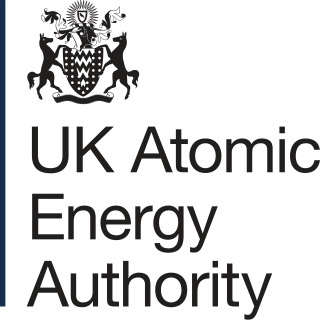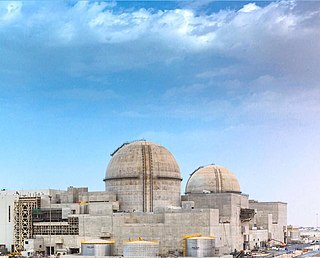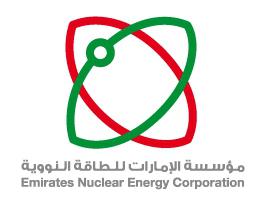Related Research Articles
Nuclear engineering is the engineering discipline concerned with designing and applying systems that utilize the energy released by nuclear processes. The most prominent application of nuclear engineering is the generation of electricity. Worldwide,some 440 nuclear reactors in 32 countries generate 10 percent of the world's energy through nuclear fission. In the future,it is expected that nuclear fusion will add another nuclear means of generating energy. Both reactions make use of the nuclear binding energy released when atomic nucleons are either separated (fission) or brought together (fusion). The energy available is given by the binding energy curve,and the amount generated is much greater than that generated through chemical reactions. Fission of 1 gram of uranium yields as much energy as burning 3 tons of coal or 600 gallons of fuel oil,without adding carbon dioxide to the atmosphere.

A nuclear thermal rocket (NTR) is a type of thermal rocket where the heat from a nuclear reaction replaces the chemical energy of the propellants in a chemical rocket. In an NTR,a working fluid,usually liquid hydrogen,is heated to a high temperature in a nuclear reactor and then expands through a rocket nozzle to create thrust. The external nuclear heat source theoretically allows a higher effective exhaust velocity and is expected to double or triple payload capacity compared to chemical propellants that store energy internally.

The United Kingdom Atomic Energy Authority is a UK government research organisation responsible for the development of fusion energy. It is an executive non-departmental public body of the Department for Energy Security and Net Zero (DESNZ).
Atomic Energy of Canada Limited (AECL) is a Canadian federal Crown corporation and Canada's largest nuclear science and technology laboratory. AECL developed the CANDU reactor technology starting in the 1950s,and in October 2011 licensed this technology to Candu Energy.
General Atomics (GA) is an American energy and defense corporation headquartered in San Diego,California that specializes in research and technology development. This includes physics research in support of nuclear fission and nuclear fusion energy. The company also provides research and manufacturing services for remotely operated surveillance aircraft,including the Predator drones,airborne sensors,and advanced electric,electronic,wireless,and laser technologies.

The Bhabha Atomic Research Centre (BARC) is India's premier nuclear research facility,headquartered in Trombay,Mumbai,Maharashtra,India. It was founded by Homi Jehangir Bhabha as the Atomic Energy Establishment,Trombay (AEET) in January 1954 as a multidisciplinary research program essential for India's nuclear program. It operates under the Department of Atomic Energy (DAE),which is directly overseen by the Prime Minister of India.
Korea Hydro &Nuclear Power is a subsidiary of the Korea Electric Power Corporation (KEPCO). It operates large nuclear and hydroelectric plants in South Korea,which are responsible for about 27 percent of the country's electric power.
CANFLEX;the name is derived from its function:CANDU FLEXible fuelling,is an advanced fuel bundle design developed by Atomic Energy of Canada Ltd. (AECL),along with the Korean Atomic Energy Research Institute (KAERI) for use in CANDU design nuclear reactors. The designers claim that it will deliver many benefits to current and future CANDU reactors-using natural uranium or other advanced nuclear fuel cycles. These include greater operating and safety margins,extended plant life,better economics and increased power.
The Karachi Nuclear Power Plant is a large commercial nuclear power plant located at the Paradise Point in Karachi,Sindh,Pakistan.
As of 2022,nuclear power is provided by six commercial nuclear power plants in Pakistan. Pakistan is the first Muslim majority country in the world to construct and operate civil nuclear power plants. The Pakistan Atomic Energy Commission (PAEC),the scientific and nuclear governmental agency,is solely responsible for operating these power plants. As of 2018,the electricity generated by commercial nuclear power plants constitutes roughly 7.5% of electricity generated in Pakistan,Pakistan is not a party to the Nuclear Non-Proliferation Treaty but is a member of the International Atomic Energy Agency. Pakistan plans on constructing 32 nuclear power plants by 2050 and envisions 40,000 MW of nuclear power generation.
Korea Electric Power Corporation,better known as KEPCO (Korean: 켑코) or Hanjeon (Korean: 한전),is the largest electric utility in South Korea,responsible for the generation,transmission and distribution of electricity and the development of electric power projects including those in nuclear power,wind power and coal. KEPCO,through its subsidiaries,is responsible for 93% of Korea's electricity generation as of 2011. The South Korean government owns a 51.11% share of KEPCO. Together with its affiliates and subsidiaries,KEPCO has an installed capacity of 65,383 MW. On the 2011 Fortune Global 500 ranking of the world's largest companies,KEPCO was ranked 271. KEPCO is a member of the World Energy Council,the World Nuclear Association and the World Association of Nuclear Operators. As of August 2011,KEPCO possesses an A+ credit rating with Fitch Ratings,while Moody's has assigned KEPCO an A1 stable rating.
Daedeok Innopolis,formerly known as Daedeok Science Town,is the research and development district in the Yuseong-gu district in Daejeon,South Korea. The plan to concentrate research institutes and universities was made in 1967 and president Park Chunghee approved subsequent master planning in 1973. Now the district contains over 20 major research institutes and over 40 corporate research centers. There are 232 research and educational institutions to be found in Daejeon,many in the Daedeok region,among them the Electronics and Telecommunications Research Institute and the Korea Aerospace Research Institute. A number of IT venture companies have sprung up in this region due to the high concentration of Ph.Ds in the applied sciences. Korea has invested heavily in building up the research expertise for over 30 years,creating long-term research programs. Over 7,000 PhD researchers are in the sciences in Daedeok and it had the most application for patents during 2000–2011 among the National Industrial Complex.
Nuclear power is a major power source in South Korea,providing 29% of the country's electricity. The total electrical generation capacity of the nuclear power plants of South Korea is 20.5 GWe from 23 reactors,equivalent to 22% of South Korea's total electrical generation capacity.

China is one of the world's largest producers of nuclear power. The country ranks third in the world both in total nuclear power capacity installed and electricity generated,accounting for around one tenth of global nuclear power generated. As of February 2023,China has 55 plants with 57GW in operation,22 under construction with 24 GW and more than 70 planned with 88GW. About 5% of electricity in the country is due to nuclear energy. These plants generated 417 TWh of electricity in 2022 This is versus the September 2022 numbers of 53 nuclear reactors,with a total capacity of 55.6 gigawatt (GW). In 2019,nuclear power had contributed 4.9% of the total Chinese electricity production,with 348.1 TWh.

Atomics International was a division of the North American Aviation company which engaged principally in the early development of nuclear technology and nuclear reactors for both commercial and government applications. Atomics International was responsible for a number of accomplishments relating to nuclear energy:design,construction and operation of the first nuclear reactor in California (1952),the first nuclear reactor to produce power for a commercial power grid in the United States (1957) and the first nuclear reactor launched into outer space by the United States (1965).
Shivram Baburao Bhoje is a distinguished Indian nuclear scientist who worked in the field of fast-breeder nuclear reactor technology for forty years in the design,construction,operation,and research and development. Indian government has honoured him with Padma Shri in 2003,the fourth highest civilian award in India,for his distinguished service to science and engineering fields.
Saudi Arabia has no nuclear power plants. However,the country has plans to create a domestic nuclear industry in anticipation of high growth in domestic energy consumption. The government's objective is to use nuclear plants to replace oil-fired power stations,thus freeing oil for export.

The Wolseong Low and Intermediate Level Radioactive Waste Disposal Centre (WLDC) is a facility used to safely house Low to Intermediate Level radioactive waste (LILW) at Gyeongju in South Korea. The facility features a silo-type design,and its first stage allowed for up to 100,000 barrels of storage,which increased to a total capacity of 800,000 upon completion of the final stage.

The APR-1400 is an advanced pressurized water nuclear reactor designed by the Korea Electric Power Corporation (KEPCO). Originally known as the Korean Next Generation Reactor (KNGR),this Generation III reactor was developed from the earlier OPR-1000 design and also incorporates features from the US Combustion Engineering (C-E) System 80+ design. Currently in South Korea there are 3 units in operation,and 3 units in construction. Three units are completed and in commercial operation in the United Arab Emirates at Barakah,with one more under construction at the same plant.

The Emirates Nuclear Energy Corporation is the entity responsible for the deployment and ownership of nuclear energy plants in the United Arab Emirates (UAE).